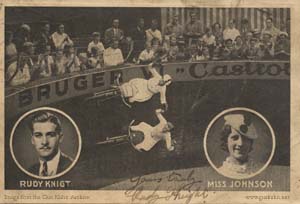|
Rudy Knight (1910 - 1989) was initially a dirt track rider who then took up the Wall of Death, a very popular fairground attraction that started in the 20s and is still operated today. To read more about the Wall of Death and the history of fairgrounds, click here.
He lived near the Kuhn family in Clapham and worked for a time as Gus's mechanic on the speedway. Gus was godfather to Rudy's first son, born in 1936.
Read here the story of his adventures during WWII when he was caught behind enemy lines after the Germans invaded France.
Read below his wife's recollections of working with him on the Wall of Death. After the war they toured with the Australian Air Aces, doing shows in Denmark and Scandinavia.
Great-great-gran's Wall of Death days |
|
MORE than half a century has passed since Bette Knight sat on the handlebars of her husband's motorbike while he rode the Wall of Death blindfolded. But the Newport great-great-grandmother remembers it as though it were yesterday. She said: "If you thought about the danger you wouldn't do it, but it was a terrific thrill."
Mrs Knight, 92, was born Bette Nelson on April 1, 1910. And she recently celebrated the birth of her family's fifth generation - with the arrival of great-great-grandson Dylan.
Bette first saw future husband Rudy Knight at Weston Wall of Death in 1934. She said: "I wanted to do it the first time I saw it. They asked for volunteers, but my friends wouldn't let me. When I was introduced to Rudy later I thought `I've seen you before somewhere,' but I didn't realise where until he mentioned that he was a rider."
It wasn't until after the war, when offers for Rudy to tour in Europe began arriving, that Bette saddled up herself. She said: "The first time I rode solo my husband had to leave - he couldn't bear to watch. There's terrific pressure when you first do it, and you must ride straight. If you lean over then you'll fall. I would sit on the handlebars while he rode blindfolded, but he wouldn't let me do the same for him."
As well as the Wall of Death, Bette - stage name The Beautiful Antoinette - rode the Globe of Death, where the motorbike is ridden upside down on the inside of a sphere. Rudy used to finish his act by riding the Wall with a lioness in the sidecar. "She loved it and knew exactly what to do. She used to enjoy it because the speed of the bike cooled her down and would purr as she went round.
"Sometimes we did a trick with three riders on the wall at once, called the Pursuit, but the timing had to be very precise - if one of us touched, we'd all fall down." Bette recalled.
Bette and Rudy left show business in 1948 so their sons could get an English education. "It was an adventurous life and interesting."
"All my life people have been saying `write a book' but we never got to write it," she added. |
| On 10 May 1940, when the machine guns sniggered into life once more as the German army invaded France, Rudy Knight was an RASC sergeant at the EFI HQ in Arras. He was evacuated to the little town of Le Ponchal, near Doullens. After a few days, the main convoy continued on to Boulogne but Captain Charles Murchie took Rudy and four other men towards his home in Lille. The group were soon cut off by the advancing Germans and while Murchie, who could pass as French, continued on home, Rudy and another sergeant were lodged in the hamlet of Conchy-sur-Canche. Supplied with money by Murchie, they stayed and worked on a farm at Conchy for the next five months.
By late summer 1940, Marseille had become the focal point for British servicemen trying to leave France and at the end of October 1940, Murchie moved down himself. He also arranged for a French courier to take Rudy and Sgt Boyle there the following month.
The French authorities arrested any British servicemen they found in the southern Unoccupied Zone and from mid-October held them at the old Foreign Legion depot of Fort St Jean in Marseille. The two sergeants were duly interned on arrival in the city. Sgt Boyle was subsequently repatriated to England on medical grounds but Rudy soon joined Murchie (who lodged in the town) in his plans to get men out of the country, either across the Pyrenees to Spain or by ship to North Africa.
Rudy was taken ill on 1 January 1941 and sent to the Michel Levy hospital. Whilst he was in the hospital, the British internees were moved from Fort St Jean to Fort St Hippolyte de Fort, about 50 kms west of Nimes, so that on Rudy's discharge he was taken to the French Military HQ of Camp St Marthe. Before he could be transferred to St Hippolyte, Murchie arranged for Rudy and three other soldiers to board a ship, the General Cambon, which sailed for the Algerian port of Oran on 20 January.
Unfortunately, all four soldiers were arrested trying to leave the harbour at Oran and sent to a series of prisons, Carnot, Medea, Aumale and in October 1941, to the infamous Laghouat internment camp, deep in the Algerian desert. They weren't released from captivity until November 1942, after the Allied landings in North Africa.
Many thanks to Keith Janes at www.conscript-heroes.com for writing this story.
His website has stories of other soldiers and airmen who escaped and evaded
during WWII
and the networks of brave souls that assisted them. |
|
.gif)
